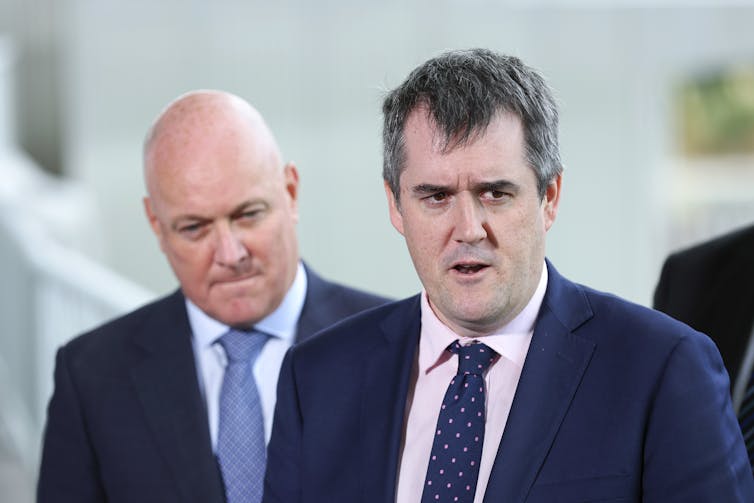Hey big spenders

This article is republished from under a Creative Commons license and written by Auckland University of Technology's John Tookey. .
New Zealand is struggling to stay ahead of its vital infrastructure needs, and the numbers show it.
The New Zealand Infrastructure Commission recently identified , most of which is currently unfunded. At the same time, the nation’s debt-to-GDP ratio hit an in September 2024.
That’s not as eye-wateringly high as the United States (124%), the UK (101%) or Japan (216.3%) – but it’s bad enough at a time when crucial infrastructure spending is overdue.
The government wants to reduce that debt ratio to within the 20-40% range. Simultaneously, however, the coalition government is committed to income and possibly .
Some might label this a form of cognitive dissonance: high investment and growth, with low taxes and spending. But in the meantime, New Zealanders can look forward to possible solutions being presented at this week’s , a central plank in the government’s “” plan.
The aspiration is to attract crucial infrastructure investment from overseas wealth funds to leverage local economic and employment growth. The mostly attending manage funds collectively worth trillions – although convincing them to spend will be harder than inviting them to the summit.
Public-private partnerships revisited
Central to the desired outcomes will be public-private partnerships (PPPs). These generally consist of consortia of funders, builders, designers and managers which construct and operate public infrastructure.
For investing in asset construction and operation, funders receive guaranteed revenue from user payments, such as road and bridge tolls or school and hospital fees. The infrastructure can then operate on rolling service contracts, or transfer to public ownership after a fixed term (commonly 25 years).
In theory, infrastructure is built, government borrowing is minimised and public services improve. In reality, PPPs try to offset capital expenditure (borrowings) against operational expenditure, thus lowering the initial debt burden but extending the terms. In effect, a hire-purchase agreement for infrastructure.
These schemes have been popular for infrastructure investment across much of the developed world since the 1990s. But increasing reliance on PPPs has also been linked to disruption in and .
For all that, and given the , New Zealand must find ways to fund major improvements to roads, rail, sanitation, drainage and housing.
The country will also need to combat a looming deficit of skilled professionals. As Engineering New Zealand noted in February, the current construction slowdown has led to a serious .

What investors want
With the in the 21st century, much basic infrastructure still reflects its 19th century origins. Indeed, New Zealand has long suffered from lags between aspiration and investment.
For example, the Public Health Acts of 1848 and 1875 instigated substantial investment in mains water and sewerage infrastructure. Yet “night soil” removal remained commonplace into the 20th century – .
Even now, Auckland’s rapid growth has seen new housing developments . Given the city’s population is likely to , it’s arguable the country is still going backwards.
However, as political commentator Matthew Hooton rightly noted last week, “”. To secure the kind of investment needed, that means projects that can demonstrate minimal risk and high revenues.
The government will open registrations of interest for the at this week’s summit. But other projects in the mix – defence force camps, prisons, court buildings – seem unlikely to meet the minimum size requirements for funders.
PPP investors are in the risk management business. Negotiations can be time-consuming, sometimes lasting years. Risks are costed into concept proposals and preliminary design.
The process, from negotiation to actual construction, can easily outlive a term of government. And there is always the temptation for subsequent governments to renegotiate the scope of a project and its costs.
But once performance requirements are set and signed off, nothing changes without additional and usually high cost increases. The recent fiasco around the Interislander ferry replacements demonstrates .
Projects that outlive governments
The prime minister will no doubt point enthusiastically to his government’s . But investors will still see a three-year electoral cycle and its risks: a 25-year PPP could outlast five or more governments – what impact will this have?
Similarly, New Zealand’s earthquake-prone geology will affect calculations. How does a PPP in an earthquake zone factor in 25-plus years of seismic risk?
There has also been a tendency to focus on the acquisition costs of major infrastructure projects, but not the . And relying on PPP funding has seen public institutions such as Britain’s National Health Service lumbered with .
Looking ahead to this week’s summit, New Zealand will need to offer projects with serious scale to attract serious investment: flood defences, major public housing, water and drainage assets, another Auckland harbour crossing, significant road improvement and replacement.
Such proposals are on the table, in theory at least. The real question is whether New Zealanders are comfortable with the dynamics of long-term contracts with substantial service charges that will last decades.
Because today’s politicians will be writing contracts our grandchildren will still be bound by.![]()